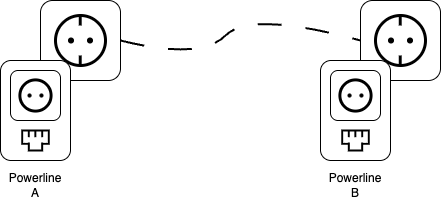A friend recently contacted me with a rare question: “do you have any idea why my network isn’t stable?”
I am living roughly 400km away. And I had an idea.
My friend loves electric vehicles (EV)s and I knew he was producing his own electricity for charging. Therefore, I checked two tings:
- Any disturbancy in his WIFI due to moving obstacles?
- Any specific timing for interruption?
He replied “no”, therefore, the third and important question came up: do you use powerline for networking. And he said “yes”. Therefore, it is pretty clear what was going on. For those of you, which do not know powerline: its a method for sending network traffic through your power cables, e.g. via electricity plugs:

Let’s take a closer look, why this might cause trouble in combination with Photovoltaik. As you might remember in physics, we have 240 Volt at 50 Hertz (frequency) for electricity in germany. This can be measured with electric instruments, such as multimeter, and will be illustrated by a sine wave:

As you see, there are 3 sine waves illustrated (blue, yellow, red), shifting between +120 V and -120 V. That’s what we call alternating current, as it goes from +120 V to -120 V. While doing so, it always goes via 0 V. The waves are rather smooth in their shape, when produced by regular, public power plants.
Let’s take a look for a different source of electricity: Photovoltaik
Photovoltaik is produced as direct current and converted by inverters to alternating current. For minimizing costs and keeping electric devices simple, these create alternated sine waves, which consist of steps instead of a flowing curve. This works for most devices at home, like lights, end-user computers etc.
When measured they look like illustrated below:

Sensitive devices, such as medical equipment require high quality electricity and may break due to low quality sine waves. Let’s take a closer look and compare both waves:
- Both follow the same voltages and frequency
- They have different qualities
- flowing curve = high quality (power plants)
- steppy curve = lower quality (self-produced)

Powerline uses the electric metrics for transfering data through electric cables. This requires a clean sine wave withoug big interferences and disturbencies:

Let’s have a closer look, on photovoltaik inverers and what kind of “background noice” they might create:
- Pulse-width modulation
as solar panels produce watts based on voltage and ampere. Voltage and ampere changes due to the amount of available sunlight, causing pulse-width modulation in the inverter for producing sinus waves. - Inverters switching operations
Pulse-width modulation is realized by high-frequency switching operations (on/off) for creating sinus waves. - Pulse frequencies of internal converters
These are 20 – 100 kHz higher than the regular 50 Hertz.
As you might already notice, inverters switching operations create multiple things:
- Interferences (steps) of the sine wave, as part of their power source (frequent changes of sun-light)
- Interferences (noise) in the cable, as part of their switch-operations
- Interferences (noise) in the sine wave frequency, as part of converting actions and quality of electronics
This lead to interrupts of a Powerline connection, especially during the day, when the sun shines.
How to address it?
There are special electronic devices to remove the caused interferences, such as:
- Ferrite cores (Sheath wave filter)
they are installed behind the inverter and reduce / remove high frequency interferences.
Also possible before and after the powerline, if the wiring inside the walls are fine. - Line filters (Electromagnetic compatibility filters / ECF)
Also remove high frequency interferences, but at larger scale than ferrit cores. - Replace inverter with ECF-Certified one
Using high-quality inverters are more costly but reduce interferences at home.



